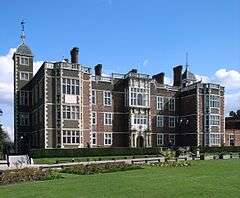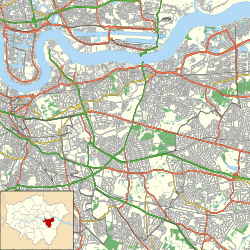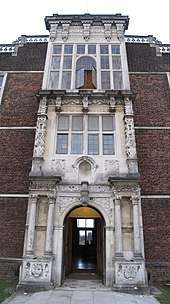Charlton House
Charlton House is a Jacobean building in Charlton, within the Royal Borough of Greenwich in south-east London. Originally it was a residence for a nobleman associated with the Stuart royal family. It later served as a wartime hospital, then a museum and library, and is now a community centre.
| Charlton House | |
|---|---|
 Charlton House, London | |
| Coordinates | 51°28′50″N 0°02′14″E |
| OS grid reference | TQ4155577714 |
| Built | 1607-1612 |
| Architectural style(s) | Jacobean |
| Owner | London Borough of Greenwich |
Listed Building – Grade I | |
| Official name: Charlton House | |
| Designated | 19 October 1951 |
| Reference no. | 1218593 |
 Location of Charlton House in Royal Borough of Greenwich | |

History
The house was built in 1607–12 of red brick with stone dressing, and has an "H"-plan layout. The interior features contemporary staircases, panelled rooms, ornamental ceilings and chimney pieces.[1]
It was built by the crown to house Sir Adam Newton and his royal charge. He was then Dean of Durham and tutor to Prince Henry, the son of James I, and older brother of the future Charles I. Greenwich Palace, where their mother lived much of the time, was nearby. But the prince died almost as soon as the house was finished, in 1612. Newton became Receiver-General, sold his office as dean, and in 1620 became a baronet.[2]
The diarist John Evelyn, who knew the house and was well acquainted with Newton's son, Sir Henry Newton, stated that the house had been built for Prince Henry. Because of Sir Adam's court connections, the designer of the house is often presumed to be John Thorpe, one of the first professional English architects, who had served as Clerk of Works for the royal palace at nearby Greenwich – the Palace of Placentia. Thorpe had left the Office of Works in 1601 for private practice.[3] Other royal connections are seen at Charlton House in the form of the Prince of Wales's feathers above the east door to the hall and in the saloon, where there is also the royal monogram, "JR" (for James I); the royal Stuart coat of arms in the west bay; and the Garter and Prince of Wales's motto, "Ich Dien" in the east bay.[4]
The garden-house, or orangery, which has been converted into a public toilet, is optimistically attributed to Inigo Jones,[4][5] who is not otherwise connected with the house. Behind the orangery is a mulberry tree said to be the oldest of its species (Morus nigra) in the country, thought to have been planted in 1608[6] at the order of James I.[4] Giacomo Castelvetro, an Italian writer stayed at Charlton and in 1613 wrote a treatise on fruit and vegetables.[7]
Adam Newton died in 1629 and his executors Peter Newton and the Scottish architect David Cunningham of Auchenharvie rebuilt nearby St Luke's Church.[8][9] Anne, Lady Halkett was married in 1656 at Charlton House, the service was conducted in her brother-in-law Sir Henry Newton's closet by Mr Robert Gale, the chaplain of Christian Cavendish, Countess of Devonshire.[10]
A wing was added by Norman Shaw in 1877. During World War I, Charlton House was the divisional headquarters of the Red Cross for Greenwich and Woolwich, and around the end of the war, from 14 October 1918 to 30 April 1919, it served as an auxiliary hospital with around 70 beds.[11]
The house and grounds were bought by the Metropolitan Borough of Greenwich in 1925.[4] The Chapel Wing was bombed during the Blitz and was subsequently rebuilt albeit with non-matching bricks such as were available in the immediate post-war period. Formerly housing a museum and library, the house is now a community centre,[4] and much of the former pleasure grounds are parks, although remnants of the house gardens survive as does a short section of Ha-Ha.[12]
The walled gardens and some of the perennial borders were redesigned and re-planted by the landscape designer Andrew Fisher Tomlin in 2003–2004 for the then London, now Royal Borough of Greenwich with perennial meadow planting to the main walled kitchen garden retaining three ancient Prunus app. trees. One of the spaces includes an Amnesty International Peace Garden with planting also designed by Fisher Tomlin.[12] The house is looked after by Royal Greenwich Heritage Trust.[12]
Film location
In 1996 the house was the main location for the feature film Monarch, released in 2000, produced and directed by local film maker John Walsh.[13]
References
- Historic England. "Charlton House (1218593)". National Heritage List for England. Retrieved 17 November 2018.
-

- Colvin, Howard A Biographical Dictionary of British Architects, 1600–1840. 3rd ed., 1995. N.B. Colvin does not mention Charlton House in connection with Jones or Thorpe.
- Palmer, Alan. "Charlton House". Greenwich Guide. Archived from the original on 8 August 2009. Retrieved 21 August 2018.
- Not by Colvin, however, who does not list it among "doubtful" attributions.
- The Charlton House Mulberry, Trees for Cities (Archived page). Accessed: 21 August 2018.
- Joan Thirsk,Food in Early Modern England (London, 2007), pp. 67-68.
- John Burke, A genealogical and heraldic history of the extinct and dormant baronetcies of England (London, 1838), p. 385
- Henry Vane, 'Historical Memoir on Charlton', Gentleman's Magazine (May 1865), pp. 576, 580.
- John Gough Nichols, Autobiography of the Lady Halkett (London, 1875), pp. xx, 102-3.
- "Charlton Manor House". Royal Greenwich Heritage Trust. Retrieved 21 August 2018.
- "Charlton Manor House: Gardens". Royal Greenwich Heritage Trust. Retrieved 17 November 2018.
- Palmer, Jim (29 August 2014). "Critically acclaimed movie Monarch shot in Charlton by Greenwich-based John Walsh set for high definition re-release". News Shopper. Retrieved 21 August 2018.
| Wikimedia Commons has media related to Charlton House. |